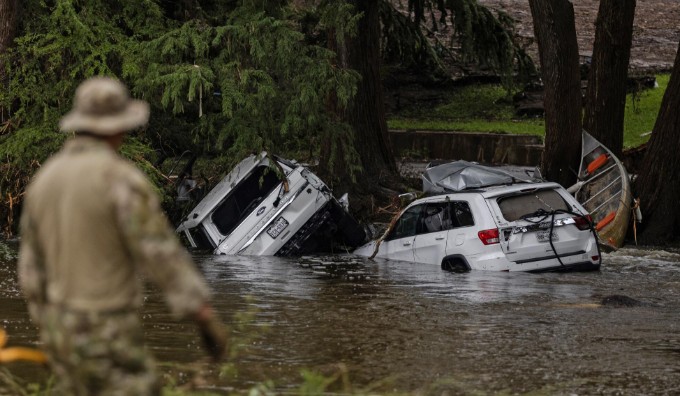It’s critical to cut through the noise of alarmist narratives of climate change and focus on the hard numbers and verifiable data when discussing events like the catastrophic Texas floods that struck the Hill Country, particularly Kerr County, over the July 4th weekend of 2025. These floods, centered along the Guadalupe River, have caused significant loss of life, property damage, and economic disruption. So lets talk on the financial toll of this disaster, drawing on available estimates and historical context, while critically examining the claim that these floods were primarily driven by climate change—a narrative often pushed to advance political agendas rather than reflect scientific reality.
Financial Costs of the Texas Floods
The Texas floods of July 2025, described as among the worst in the region’s history, have inflicted a staggering economic toll. While comprehensive damage assessments are still ongoing, early estimates and historical comparisons provide a framework for understanding the financial impact. Let’s start with Direct Property Damage. The floods, triggered by up to 15 inches of rain falling in a few hours, devastated homes, businesses, and infrastructure in Kerr County and surrounding areas. The Guadalupe River’s rapid rise—surging 26 feet in under an hour in some locations—destroyed homes, vehicles, and businesses, particularly in low-lying areas like Camp Mystic, a historic girls’ summer camp. Drawing from historical precedents, the 2002 Guadalupe River floods caused approximately $250 million in damages (unadjusted for inflation). Given the greater severity of the 2025 event, with reports of over 100 deaths and widespread destruction, estimates suggest damages could exceed $1 billion in 2025 dollars. Infrastructure losses include washed-out roads, bridges, and public facilities. For example, the Cade Loop bridge in Ingram was heavily damaged, and debris removal costs alone are expected to run into the tens of millions. Harris County’s flood infrastructure plan, adjusted for increased rainfall intensity, recently saw costs rise by $150–$200 million due to flood safety needs. Similar cost escalations are likely for Kerr County’s recovery efforts, particularly for rebuilding flood defences and infrastructure.
Then there is Economic Disruption. The floods struck during the July 4th holiday, a peak tourism period for the Texas Hill Country, known for its scenic rivers and outdoor attractions. The destruction of RV parks, campsites, and local businesses has disrupted tourism revenue, a significant economic driver for the region. Kerr County, with a median household income of $68,000 and a modest $67 million annual budget, lacks the fiscal capacity to absorb these losses without federal or state aid. Business interruptions, particularly in agriculture and small retail, are expected to cost millions in lost revenue. Livestock losses and damage to farmland, swept away by floodwaters, further compound the economic hit. Search-and-rescue operations, involving hundreds of first responders and military personnel, have already incurred significant costs, likely in the range of $10–$20 million based on comparable disaster response efforts.
looking at Long-Term Economic Impacts, rebuilding efforts will likely take years, with costs escalating due to inflation and supply chain constraints. The 2021 Texas winter storm, for comparison, cost an estimated $20–$130 billion in total economic impact, and the 2025 floods, while more localized, could approach $5–$10 billion when factoring in long-term recovery and lost economic activity. Insurance payouts for property damage and business interruption will strain insurers, potentially leading to higher premiums across Texas. Uninsured losses, particularly in flood-prone areas without adequate coverage, will burden homeowners and small businesses, further depressing local economies.
Debunking the Climate Change Narrative
The mainstream media and certain political figures have been quick to attribute the Texas floods to climate change, citing a warmer atmosphere’s ability to hold more moisture as the primary driver of extreme rainfall. This narrative, however, oversimplifies a complex meteorological event and ignores critical context about the region’s natural weather patterns and forecasting challenges.
Central Texas Is Naturally Flood-Prone
The Texas Hill Country, colloquially known as “Flash Flood Alley,” has a long history of extreme flooding due to its unique geography and meteorology. The region’s limestone hills and shallow river basins, combined with moist air from the Gulf of Mexico, create ideal conditions for flash floods. Historical records show significant flooding along the Guadalupe River in 1978, 1987, and 2002, with the 2002 event causing $250 million in damages and seven deaths. These events predate the modern climate change narrative, indicating that catastrophic floods are a recurring feature of the region, not a new phenomenon.
Politicization of Natural Disasters
Democrats and media outlets have seized on the floods to attack the Trump administration’s cuts to NOAA and FEMA, alleging that these reductions led to inadequate warnings and response. However, the White House and meteorologists have countered that NWS forecasts were accurate and timely, with extra staff on duty during the event. Critics like Rep. Jared Huffman and Gov. Jay Inslee have linked the floods to Trump’s broader climate policies, including the “One Big Beautiful Bill Act” that slashed renewable energy credits and NOAA funding. These claims conveniently ignore that the proposed $2.2 billion NOAA budget cut for 2026 had not yet taken effect and thus could not have impacted the 2025 floods.
Evidence Supporting Weather Modification as a Contributor
Meanwhile, concerns are swirling about suspected weather modification operations in the area. Growing concerns—amplified by posts on X and public skepticism—point to weather modification operations, specifically cloud seeding, as a potential contributor to the disaster.
Active Cloud Seeding Programs in Texas
Texas operates seven state-authorized cloud seeding programs under the 1967 Texas Weather Modification Act, covering 31 million acres in regions like the Panhandle, West Texas, and South Texas. These programs, managed by the Texas Department of Licensing and Regulation (TDLR), use aircraft to disperse silver iodide into convective clouds to enhance rainfall, primarily for drought relief.
- Augustus Doricko, CEO of Rainmaker Technology Corp., confirmed a 20-minute cloud seeding mission in south-central Texas on July 2, 2025, just two days before the floods.
The TDLR claims cloud seeding produces minimal rainfall (fractions of inches annually) and denies it causes flash floods. However, a 2019 Texas Tech University study found seeded thunderstorms produced 24% more rain and lasted 41% longer than unseeded storms, suggesting a potential to amplify existing weather systems.
- The July 2025 floods involved a mesoscale convective complex with 5–18 inches of rain, described as a 500- or 1,000-year event. Cloud seeding, even if they claim it did not directly cause the storm, it intensified moisture-laden clouds, contributing to the extreme rainfall. The lack of transparency about specific seeding locations and atmospheric impacts fuels this speculation. The timing of seeding operations two days prior, questioning why such activities continued in a region already under flood watches, suggesting a lack of caution by operators.
It is safe to say that these floods were linked to “cloud seeding, geoengineering, & manipulation.” The TDLR requires operators to report seeding activities to NOAA within 10 days, but these reports are often delayed by months, limiting public oversight. Rainmaker’s decision to suspend operations after July 2 due to “abnormally high moisture” suggests operators were aware of heightened flood risks, yet the mission proceeded. This raises questions about oversight and seeding exacerbated an already volatile atmosphere.
Publicly available documents reveal that the U.S. Congress has been quietly approving funding for weather modification and geoengineering projects. New documents show that Congress has allocated funding for these projects without any studies on the impact on human health or public consent. This information is accessible through the website usaspending.gov. In response, 24 states have begun taking action against these projects, including: Arizona, Connecticut, Florida, Idaho, Illinois, Indiana, Iowa, Kentucky, Maine, Minnesota, Mississippi, Missouri, New Hampshire, North Dakota, Ohio, Oklahoma, Pennsylvania, Rhode Island, South Carolina, South Dakota, Tennessee, Texas, Utah, Wyoming
Written By Tatenda Belle Panashe



